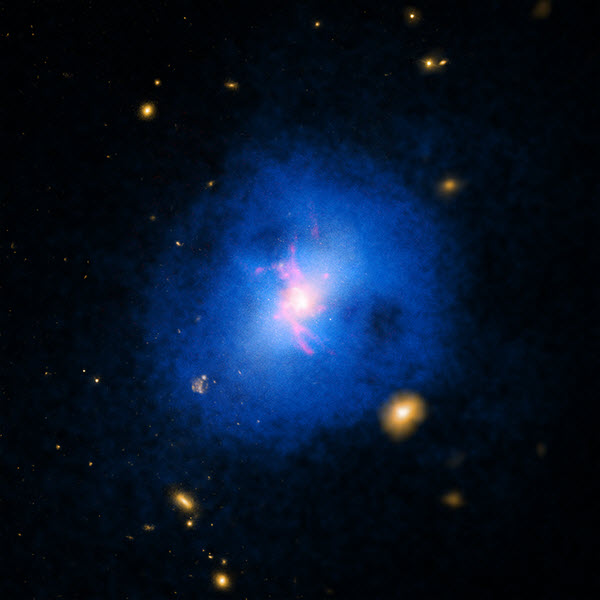Oops, the universe may have ten to 100 times fewer galaxies than we thought
July 2, 2015

There may be far fewer galaxies further out in the universe then might be expected, according to a new study led by MSU (credit: NASA/CXC/STSci/DSS/Magellan)
There may be far fewer galaxies further out in the universe then might be expected, according to a new study led by Michigan State University.
Over the years, the Hubble Space Telescope has allowed astronomers to look deep into the universe. The long view stirred theories of untold thousands of distant, faint galaxies. But new research appearing in the current issue of the Astrophysical Journal Letters offers a new theory that reduces the estimated number of the most distant galaxies by 10 to 100 times.
“Our work suggests that there are far fewer faint galaxies than we once previously thought,” said Brian O’Shea, MSU associate professor of physics and astronomy. “Earlier estimates placed the number of faint galaxies in the early universe to be hundreds or thousands of times larger than the few bright galaxies that we can actually see with the Hubble Space Telescope. We now think that number could be closer to ten times larger.
“The most fundamental characteristics of the earliest galaxies are challenging to determine directly,” the astronomers note in an open-access draft arXiv paper. “These galaxies lie at the edge of observability, or beyond, for even the largest current ground- and space-based telescopes, and inferences based on local stellar populations (from, e.g, the MilkyWay’s stellar halo) are uncertain at best.”
O’Shea and his team used the National Science Foundation’s Blue Waters supercomputer to run simulations to examine the formation of galaxies in the early universe. The team simulated thousands of galaxies at a time, including the galaxies’ interactions through gravity or radiation.
The simulated galaxies were consistent with observed distant galaxies at the bright end of the distribution — in other words, those that have been discovered and confirmed. The simulations didn’t, however, reveal an exponentially growing number of faint galaxies, as has been previously predicted. The number of those at the lower end of the brightness distribution was flat rather than increasing sharply, O’Shea added.
These simulations will be tested further when the much-anticipated James Webb Space Telescope comes online in late 2018. The improved technology will afford astronomers even more-detailed views of space than the amazing images that the Hubble has produced in recent years.
The Hubble Space Telescope can see the tip of the iceberg of the most-distant galaxies, said Michael Norman, co-author of the paper and director of the San Diego Supercomputer Center at the University of California, San Diego. “A deeper understanding based on theory may be necessary to correctly interpret what’s being seen, such as high redshift survey results,” he said.
In addition to O’Shea and Norman, the research team also included John Wise, an assistant professor at the Georgia Institute of Technology, and Hao Xu, a postdoctoral research associate at the University of California, San Diego.
The research was funded by the National Science Foundation and NASA.
Abstract of Probing the ultraviolet luminosity function of the earliest galaxies with the renaissance simulations
In this paper, we present the first results from the Renaissance Simulations, a suite of extremely high-resolution and physics-rich AMR calculations of high-redshift galaxy formation performed on the Blue Waters supercomputer. These simulations contain hundreds of well-resolved galaxies at
z ~ 25-8, and make several novel, testable predictions. Most critically, we show that the ultraviolet luminosity function of our simulated galaxies is consistent with observations of high-z galaxy populations at the bright end of the luminosity function M1600 ≤ 17, but at lower luminosities is essentially flat rather than rising steeply, as has been inferred by Schechter function fits to high-z observations, and has a clearly defined lower limit in UV luminosity. This behavior of the luminosity function is due to two factors: (i) the strong dependence of the star formation rate (SFR) on halo virial mass in our simulated galaxy population, with lower-mass halos having systematically lower SFRs and thus lower UV luminosities; and (ii) the fact that halos with virial masses below ≅2 × 108 Mʘ do not universally contain stars, with the fraction of halos containing stars dropping to zero at ≅7 × 106 Mʘ. Finally, we show that the brightest of our simulated galaxies may be visible to current and future ultra-deep space-based surveys, particularly if lensed regions are chosen for observation.